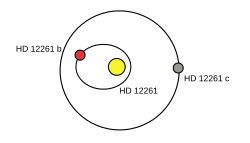Properties
The apparent visual magnitude of this star is 7.42, [3] making it too faint to be viewed by the naked eye even under ideal viewing conditions. However, it can be readily observed using a small telescope with an aperture of 6 cm (2 in) or more. [8] Parallax measurements of HD 12661 place it at a distance of about 123.6 light-years (37.9 parsecs ) from the Earth, with a margin of error of ±0.2 light years. [2] It has a stellar classification of G6 V, indicating that it is a main sequence star that is generating energy through the thermonuclear fusion of hydrogen at its core. The effective temperature of the star's outer envelope is about 5,754 K, [4] giving it the characteristic yellow hue of a G-type star. [9] Based on stellar models, estimates of the radius of this star range from 107% to 112% times Sun's radius, while the mass is likely in the range from 107% to 110% of the Sun's mass. [4] [5]
As a star ages it slows its rotation and diminishes the amount of magnetic activity in its chromosphere. Hence the measured emission from the chromosphere can be used to estimate the age of a star, particularly for F and G-type dwarf stars with an age of less than two billion years. However, this technique becomes less accurate for ages beyond about 5.6 billion years. Based upon the chromosphere emission of HD 12661, it is older than the Sun with an estimated age of roughly seven billion years. [10] It has a low projected rotational velocity of 1.20 km/s, consistent with it being an older star. [5] The age of a star can also be estimated by the abundance of lithium, as this element is destroyed through thermonuclear fusion at the core. However, this is less accurate technique. For HD 12661, the lithium abundance gives an age estimate of 4.4 billion years. [10]
The abundance of elements other than hydrogen and helium, what astronomers term the metallicity, is unusually high in this star when compared to the Sun. High metallicity has been found to be statistically correlated with the presence of a multi-planet system around a star. [4] It is possible that a planet in this system may have been scattered and ended up being accreted by the star, which may account for the large surface metallicity. [11]
This page is based on this
Wikipedia article Text is available under the
CC BY-SA 4.0 license; additional terms may apply.
Images, videos and audio are available under their respective licenses.
